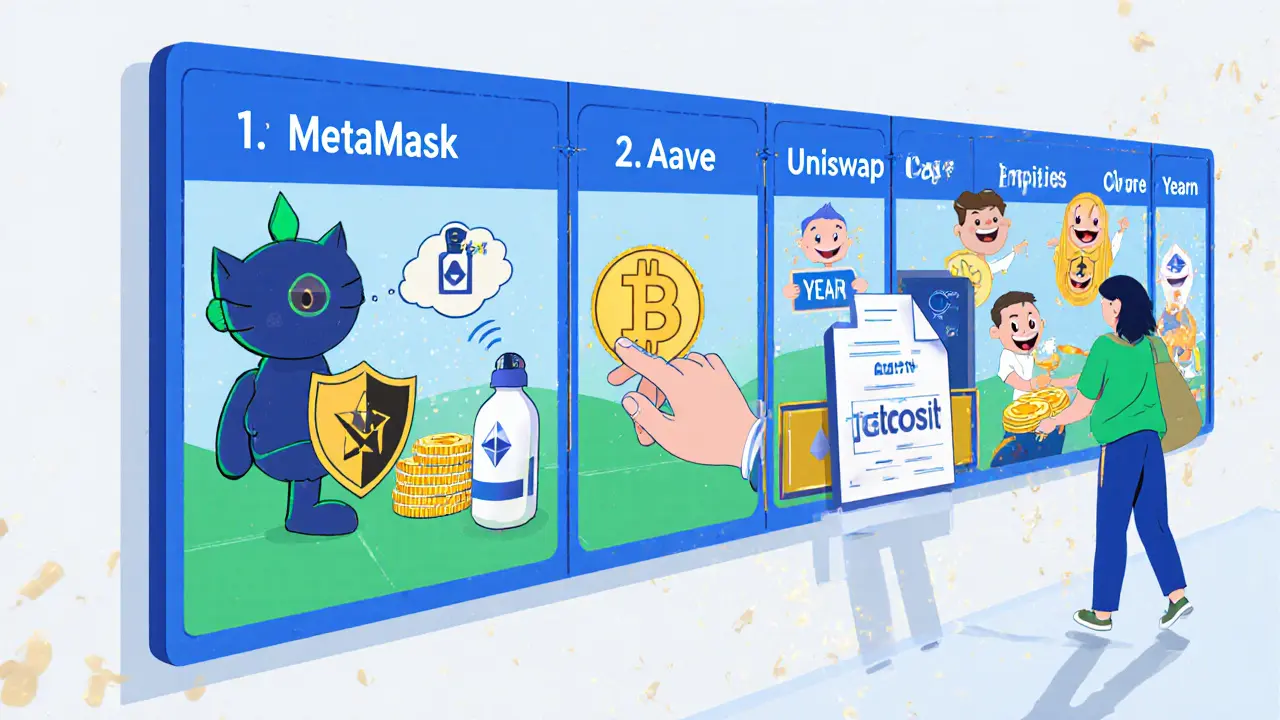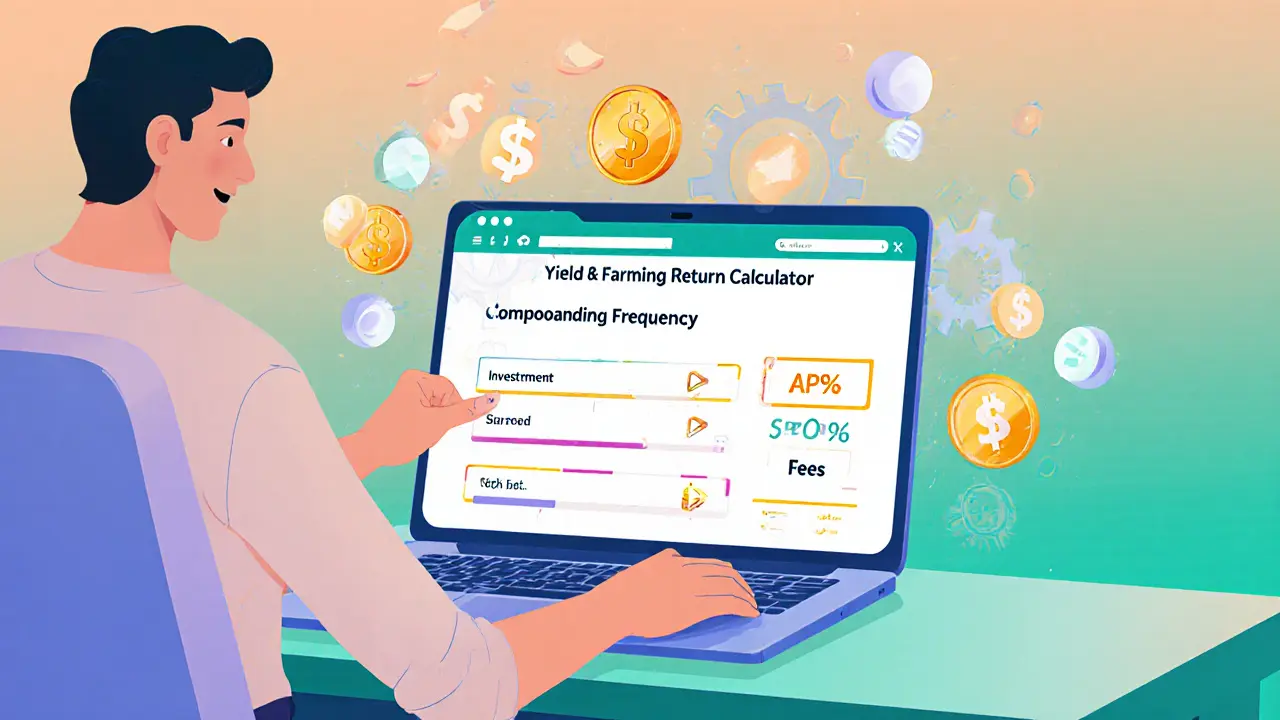Yield Farming Return Calculator
Projected Annual Return
Yield farming is a DeFi strategy where users lock crypto assets in protocols to earn interest, fees, or token rewards. It works like a high‑yield savings account, but the "bank" is a smart contract on a blockchain. If you’re looking for a way to grow crypto holdings without constant trading, this guide walks you through the whole process-from picking a wallet to managing risk.
Key Takeaways
- Set up a compatible wallet (MetaMask, Trust Wallet, Coinbase Wallet).
- Fund it with a pair of assets and enough native gas (ETH, BNB, etc.).
- Choose a reputable protocol (Aave, Uniswap, Curve, Yearn).
- Start simple: single‑asset staking or stablecoin pools.
- Use auto‑compounding vaults or protocol stacking only after you understand the risks.
Understanding the Core Concepts
Before you dive in, get clear on the main building blocks of the ecosystem.
Decentralized Finance (DeFi) is a collection of blockchain‑based financial services that operate without traditional intermediaries. Yield farming lives inside DeFi, leveraging liquidity‑providing, lending, and staking mechanisms.
Each protocol relies on a smart contract self‑executing code that enforces the rules of a financial operation. When you deposit, the contract automatically distributes rewards.
Step 1 - Choose and Secure Your Wallet
The first interaction point is your wallet. It holds private keys and lets you sign transactions.
MetaMask is a browser extension and mobile app that supports Ethereum and many compatible chains is the most popular choice, but Trust Wallet and Coinbase Wallet work equally well on mobile‑first users.
- Download the extension or app from the official site.
- Create a new seed phrase; write it down offline.
- Enable the network you plan to farm on (Ethereum, Binance Smart Chain, Optimism, etc.).
Step 2 - Fund Your Wallet
Yield farming usually needs two things: the asset you want to earn yields on, and the native token to pay gas fees.
For a simple stablecoin farm, buy USDC a USD‑pegged stablecoin on an exchange and transfer it to your wallet. Keep a small amount of ETH the native gas token for Ethereum (or BNB for BSC) to cover transaction costs.
How much to start?
- Decide your risk budget - many beginners start with $500‑$1,000.
- Allocate ~2-3% of that amount for gas fees (prices fluctuate, especially on Ethereum).
- Leave a safety buffer; you can always add more later.
Step 3 - Pick a Yield Farming Platform
Reputation, total value locked (TVL), and audit history are the three pillars of platform selection.
- Aave a lending protocol that lets you earn interest by supplying assets.
- Uniswap a decentralized exchange where you can provide liquidity and collect trading fees.
- Curve optimised for stablecoin swaps and low‑slippage pools.
- Yearn Finance an aggregator that auto‑optimises returns across multiple vaults.
Check each protocol’s audit reports (e.g., CertiK, Trail of Bits) and community forums for red flags.
Step 4 - Provide Liquidity or Stake Assets
The exact UI varies, but the core steps are similar.
- Navigate to the “Earn” or “Liquidity” tab on the chosen platform.
- Select the pool you want - e.g., USDC/USDC (single‑asset) on Aave or USDC‑ETH on Uniswap.
- Enter the amount, approve the token spend (you’ll sign a transaction), and confirm the deposit.
- After the transaction confirms, you receive LP tokens proof of your share in a liquidity pool or a staking receipt.
These tokens represent your claim on future rewards and can be withdrawn at any time (subject to lock‑up periods).

Step 5 - Track Rewards and Calculate Returns
Two metrics dominate the conversation: APR (annual percentage rate) and APY (annual percentage yield). APR shows simple interest; APY includes compounding.
Example: A pool advertises 12% APR, compounded monthly. The APY becomes about 12.68% because each month you earn interest on the prior month’s earnings.
Use a yield‑farming calculator (many DeFi dashboards have built‑in tools) and plug in:
- Initial capital.
- Displayed APR or APY.
- Compounding frequency (daily, weekly, auto‑vault).
Remember to subtract gas costs and any platform fees (usually 0.1%-0.3%).
Strategy Comparison
| Strategy | Risk Level | Typical APY | Complexity | Best For |
|---|---|---|---|---|
| Single‑Asset Staking (e.g., Aave USDC) | Low | 3‑6% | Easy | Beginners, capital preservation |
| LP Farming (e.g., ETH‑USDC on Uniswap) | Medium (impermanent loss) | 10‑25% | Moderate | Those comfortable with price swings |
| Protocol Stacking (Vaults + Auto‑Compounding) | High (smart‑contract + market risk) | 30‑70%+ | Hard | Experienced growers seeking max yield |
Step 6 - Auto‑Compounding and Vaults
If you don’t want to manually harvest rewards, consider an auto‑compounding vault.
Yearn Finance offers vaults that automatically claim, swap, and reinvest rewards. The process is:
- Deposit your LP tokens or stablecoins into the vault.
- The vault’s strategy contract harvests rewards (e.g., YFI, CRV) every few hours.
- Rewards are swapped to the base asset and added back, compounding your position.
Fees usually range from 5‑10% of the earned yield, but the hands‑off nature is worth it for many.
Risk Management Essentials
Yield farming promises high returns, but the pitfalls can wipe out capital fast.
- Impermanent loss: Occurs when the price ratio of paired assets diverges. Use stablecoin pools to minimise.
- Smart‑contract bugs: Even audited code can have hidden exploits. Diversify across several audited platforms.
- Market volatility: A sudden drop in token price can trigger liquidations if you’re leveraged.
- Depeg events: Stablecoins sometimes lose their peg; keep a mix of reputable versions (USDC, USDT, DAI).
Practical tips:
- Never allocate more than 10‑15% of your total crypto portfolio to high‑risk farms.
- Set stop‑loss thresholds on leveraged or borrow‑back strategies.
- Monitor TVL and reward rate changes weekly; move funds if incentives dip sharply.
- Keep a small reserve of native gas tokens to avoid being stuck during network congestion.
Putting It All Together - A Sample Beginner Walkthrough
Let’s walk through a concrete example using USDC on Aave.
- Install MetaMask and fund it with $1,000 USDC + 0.02 ETH for gas.
- Visit Aave (no link required by brief, just mention). Connect your wallet.
- Navigate to the “Deposit” tab, select USDC, and enter $500.
- Confirm the transaction; you’ll see a receipt confirming a 4.5% APR plus a weekly AAVE token reward.
- Optional: Stake the earned AAVE tokens in the Aave safety module for an extra 2% boost.
- Track your balance in the Aave dashboard; every week you can claim AAVE or let it auto‑compound.
At the end of the month, after accounting for gas fees, you could expect roughly $20‑$25 in total yield - a solid start for a low‑risk entry point.
Next Steps and Ongoing Monitoring
Yield farming isn’t a set‑and‑forget hobby. Treat it like a small portfolio you review regularly.
- Weekly: Check reward rates, TVL shifts, and any announced protocol upgrades.
- Monthly: Re‑balance - move funds from under‑performing pools to higher‑yielding, still‑audited options.
- Quarterly: Re‑evaluate your risk tolerance; consider stepping up to auto‑compounding vaults if you’re comfortable.
By staying disciplined and spreading risk, you can turn crypto holdings into a genuine source of passive income.
Frequently Asked Questions
What is the difference between APR and APY?
APR shows the simple yearly interest rate, while APY adds the effect of compounding. APY will always be equal to or higher than APR, depending on how often rewards are reinvested.
Do I need to stay on the same blockchain for the whole process?
Not necessarily. You can bridge assets to another chain if you want better yields, but each bridge adds its own risk and cost. Evaluate the bridge’s security and fees before moving.
How risky are stablecoin farms?
Stablecoin farms are among the safest DeFi options because the assets are pegged to the dollar, reducing price volatility. The main risks are depeg events and smart‑contract bugs.
Can I withdraw my funds at any time?
Most single‑asset staking and many LP pools allow instant withdrawal, though you’ll pay a gas fee. Some vaults impose a cooldown period; check the protocol’s terms before depositing.
What’s the best way to diversify my yield farms?
Spread capital across at least three categories: a low‑risk stablecoin pool, a mid‑risk blue‑chip LP (e.g., ETH‑USDC), and a high‑yield auto‑compounding vault. This mix balances stable returns with growth potential.


Marie-Pier Horth
Behold the alchemy of yield farming, where idle tokens are coaxed into blossoming returns.
By staking assets on reputable platforms, one can harvest passive income without daily toil.
Yet beware the hidden drifts of gas fees that erode the golden yield.
In the end, discipline and research are the true catalysts.